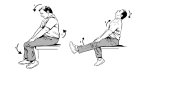Hello,
I am working with an individual who has diagnosed with sciatica. Their doctor has basically said it's there and it'll go away eventually, but hasn't really provided any "guidelines" for training. This individual still wants to come in and train, but I'm kind of unsure/hesitant how to move forward with them. I've never had sciatica or worked with someone who has.
What tends to irritate sciatica? What tends to decrease symptoms? Are there training exercises or strategies to avoid during a "flare up?" Or any thing to include during a flare up that can help?
Obviously, I'm not a medical professional and I'm not looking at getting or giving medical advice, but I am looking for hopefully a better understanding of this so I can train my client better.
All the best and thank you in advance for your thoughts!
j
I am working with an individual who has diagnosed with sciatica. Their doctor has basically said it's there and it'll go away eventually, but hasn't really provided any "guidelines" for training. This individual still wants to come in and train, but I'm kind of unsure/hesitant how to move forward with them. I've never had sciatica or worked with someone who has.
What tends to irritate sciatica? What tends to decrease symptoms? Are there training exercises or strategies to avoid during a "flare up?" Or any thing to include during a flare up that can help?
Obviously, I'm not a medical professional and I'm not looking at getting or giving medical advice, but I am looking for hopefully a better understanding of this so I can train my client better.
All the best and thank you in advance for your thoughts!
j



